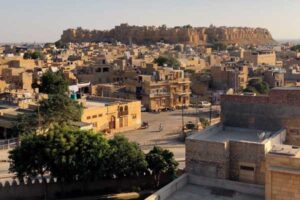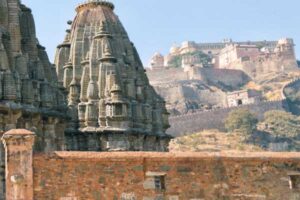Jaigarh Fort jaipur
Overview Of Jaigarh Fort
One of the best examples of the period when the great Rajput kings and queens popularized customized construction designs in Jaipur’s Jaigarh Fort. The “Victory Fort,” as its name implies, was constructed to fend off state adversaries from Amer Fort and the enormous royal complex it held.
The Aravalli Mountains in Rajasthan are home to the massive Jaigarh Fort. One of the world’s most impressive fortifications, it towers 500 meters above average sea level. Famous as “The Red Fort,” it had its inception in 1726 by Raja Jai Singh II to bolster the fortifications of the Amer Fort.The Jaigarh Fort provides a spectacular picture of the green hills and lakes in the vicinity. You can visit these places in addition to an unobstructed view of the Amer Fort and its surrounding complex. When compared to other historical monuments, it has several unique features that make it one of the most noteworthy in the Jaipur area. The world-famous Jaivana Cannon, which can be found inside these fortifications, is the largest cannon in existence. Indeed, the building of the cannon took place reportedly inside the Jaigarh Fort. It was in use in a number of significant Rajput battles and skirmishes.
Other temples inside the fort include the Aram Mandir, Vilas Mandir, Laxmi Vilas, and the Lalit Mandir. The fort’s four portions of the Persian garden are under separation by lattice-work windows. From them one can see the vast landscape that surrounds the structure. Originally, the Amer Fort planned to utilize the Jaigarh Fort as a supply depot for its weapons and ammunition in the case of an attack.
COST EFFICIENT SERVICES
Provide highly efficient services at very competitive prices.
ATTRACTIVE PACKAGES
Exclusively customized packages for Rajasthan & India tours.
CAR RENTAL SERVICES
Hire a taxicab in Jaipur for local sightseeing and outstation needs.
100% SATISFACTION
Our company provides 100% customer satisfaction as it is our top priority.
24+ Year
Experience
20+ Tour
Destinations
15000 + Happy
Customers
History Of Jaigarh Fort
In 1726, Jai Singh II, the reigning monarch, gave the order to build Jaigarh Fort in Jaipur. The vast plan of the fort, which overlooked Amer Fort, was meant to suggest its regal status and extravagance. The monarch didn’t so much order its construction as a personal home as a defensive fortress. The subterranean tube connecting Amer Fort with Jaigarh Fort, which enables people to escape to safety in the event of an assault on either fort, is the fort’s main feature.Perched atop the Hill of Eagles, also known as Cheel ka Teela, the fort commands stunning views of the Aravalli Range and the lovely Maota Lake.
Numerous Rajput kings lived there, and it also functioned as a stronghold where they kept their armament, ammunition, and artillery stockpiles. It was intended to serve as the Mughal Empire’s principal cannon manufacturing plant for the sultans.Throughout the several battles that broke out in the Mughal empire that year, the cannon outpost was held until its last defender, Dara Shikoh, was killed by his own brother, Aurangzeb.
During the time of Mughal Emperor Shah Jahan, the Jaigarh Fort became known as the most productive cannon factory in the world. It is most likely because of the abundant iron ore mining in the area that the fort is known as the “Iron Fort.” The cannon foundry’s wind tunnel, which reportedly reaches temperatures of up to 2400 degrees Fahrenheit, aids in the melting of metal required to make cannons. Using accurate gear systems, this apparatus—powered by four teams of oxen—was utilised to hollow down cannon barrels. The Rajputs gained international notoriety for inventing this device.
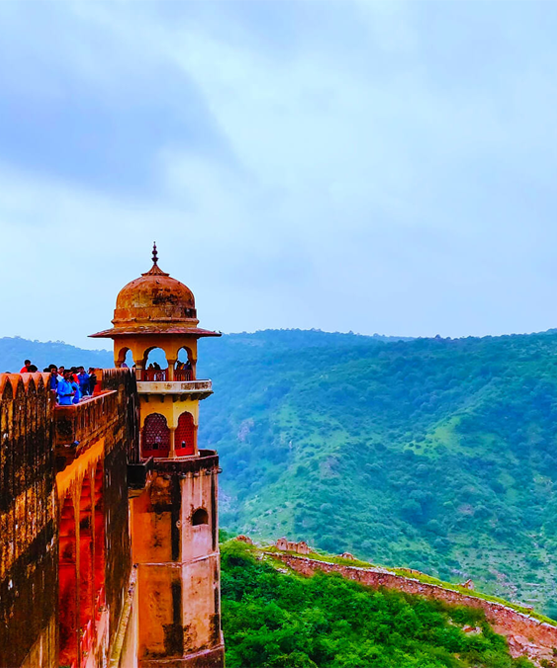
Architecture Of Jaigarh Fort
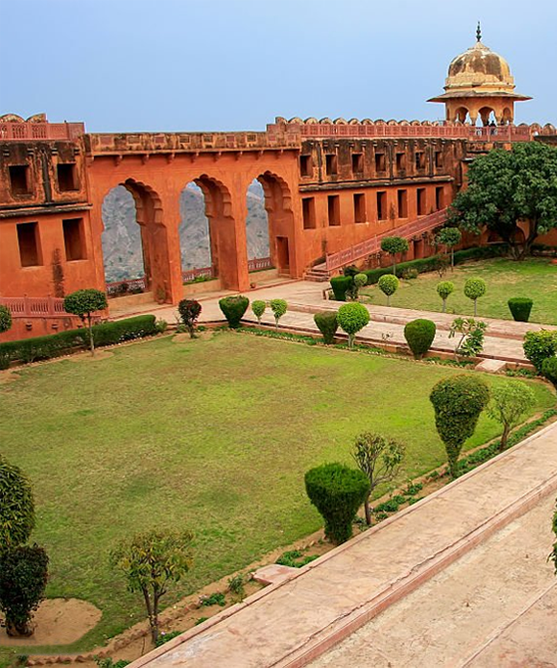
Contemporary architectural genius Vidyadhar planned, conceptualized, and implemented the Jaigarh Fort to near perfection. For the fort, Raja Jai Singh II was the selected name. It was constructed as a tribute to the city’s rich history, which is still evident today. Replete with the opulence and decoration befitting a monarch or queen, the massive edifice is an accurate portrayal of the period it represents. The red sandstone that was used to build the fort was the primary building material used for most Rajput and Mughal forts. The fort’s remarkable walls and elaborate carvings illustrate the fort’s durability even now by narrating the narrative of its lengthy and exciting past.
Inside this amazing building are some of the most well-known temples in the world, including the Lalit, Vilas, Aram, and Laxmi Vilas Mandirs. The overall charm of the fort is enhanced by two more historic temples: the Ram Harihar temple, constructed in the tenth century, and the Kal Bhairav temple, constructed in the twelfth century. The incredible fort is one kilometer wide and three km long. ‘Jaivana,’ the world’s largest mobile cannon, may be found here.
Despite its smaller size than the other two forts in Jaipur, this one is the biggest. Its adversaries never really put up much of a fight, which is perhaps part of the reason the fort got the moniker “Victory Fort.” It has never been overseen by another person. For those who are interested in learning more about Rajput culture and history, the fort and all of its attractions are a must-see. It is still possible to visit the fort today.
What To See

Jaigarh Fort, built at a massive scale and styled by Indo-Persian architecture, was full of almost entirely out of sandstone. Lime mortar was under usage to bind the cyclopean walls together. A square garden serves as the base for the structure, which has by walls that rise to the upper floors on all sides around. Also, right in the heart of everything, you’ll find a watchtower with 360-degree views of the gorgeous scenery. The fort’s construction is fascinating, and the lattice windows are a standout feature. This is indeed an impressive feature of the fort. Windows in this structure have been designed to let those inside see the outdoors clearly without letting anybody outside see what’s going on inside.
The Dungar Darwaza is the name of the main entrance of the Jaigarh fort. On the grounds of the fort are two ancient temples, the Kal Bhairav Temple and the Ram Harihar Temple. The Ram Harihar Temple was built in 10th century, whereas this Kal Bhairav Temple wasn’t erected until the 12th. Visitors may learn about the unique architectural and construction techniques employed by the Rajputs while marvelling at their magnificent courtrooms, baths, assembly halls, and other venues. The fort’s several defensive gates are strategically in place to take use of the surrounding landscape, which includes the Aravalli Hills and Sagar Lake.
Things To Do In Jaigarh Fort, Jaipur
Jaivana Cannon
The biggest Cannon on Wheels, known as the “Jaivana Cannon,” is on exhibit in the Jaigarh Fort. Sawai Jai Singh II had it constructed to the finest standards. Since its erection in 1720, it has remained steadfast in its position inside the fort. In Jaigarh, in a foundry, the Jaivana was made under Maharaja Sawai Jai Singh II’s (1699–1743) rule. The barrel weighs 50 tonnes and has an actual length of 20.19 feet (6.15 metres). Its diameter has a circumference of 11 inches (280 mm).
There are carvings of a tree, many ducks or birds, and an elephant scroll on the barrel. It can fire in any direction and spin a full 360 degrees since it has two back wheels that are placed on roller pin bearings. The cannon was enclosed in an aluminium shelter to protect it from the weather.
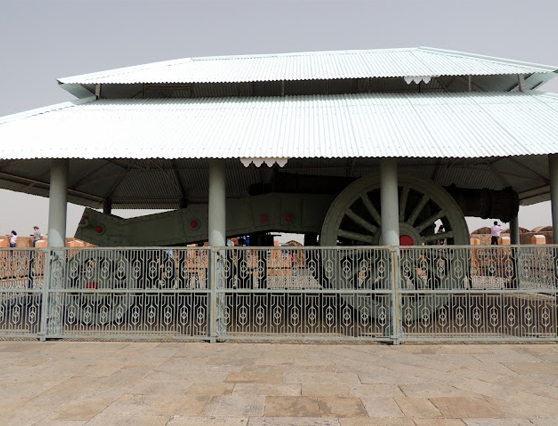
There are carvings of a tree, many ducks or birds, and an elephant scroll on the barrel. It can fire in any direction and spin a full 360 degrees since it has two back wheels that are placed on roller pin bearings. The cannon was enclosed in an aluminium shelter to protect it from the weather. With a range of over ten kilometres, the cannon was capable of firing projectiles weighing up to fifty kilogrammes (110 pounds). The complex’s northern section is home to the well-known Aram Mandir and the tasteful Charbagh Garden, both of which have Persian architectural elements.
A stunning museum that pays tribute to the history and culture of the fort’s period is located within the Jaigarh Fort. The Royalty of Jaipur’s stamps are supposed to provide tourists a glimpse into the royal lifestyle, along with other unusual objects like portraits, puppets, and other military amenities. A 15th-century spittoon and a set of spherical playing cards are also on display at the museum. The museum has a hand-drawn map or illustration of the fort and palace. With a range of over ten kilometres, the cannon was capable of firing projectiles weighing up to fifty kilogrammes (110 pounds). The complex’s northern section is home to the well-known Aram Mandir and the tasteful Charbagh Garden, both of which have Persian architectural elements.
Armoury
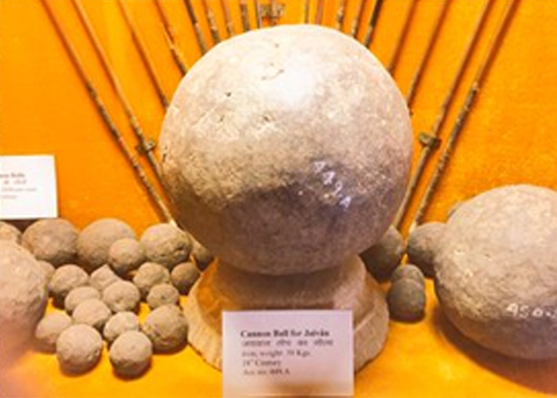
A massive 50 kg (110 lb) cannonball is one of the many weapons on show in this area, along with several other weaponry, swords, time bombs, camel-mounted cannons, muskets, and shields. This location is called by the natives Vijay Garh. Maharaja Jai Singh II is said to have tested the cannon in 1720 by firing it 37 kilometers distant at a place known as “Chaksu,” where it is claimed to have created a crater that is now filled with a lake. Other than the cannon, it was assumed that the cannoneer had perished before he could try to leap into the lake.
There are now old pictures of the Maharajas of Jaipur on exhibit. Among them are Sawai Bhawani Singh and Major General Man Singh II, two well-known Indian military figures. It also has a beautiful treasure lock, to which all five keys are included. There are rumors that the armory has a great deal of armaments and military items that were used in the Rajput and Mughal battles of the 18th century.
Other Structures
The Diwan-i-Aam, Khilbat Niwas, Shubhat Niwas, and Diya Burj are said to be additional notable architectural masterpieces housed inside the palace. Diya Burj is the highest point on the fort. It is reported that the Rajputs and the Mughals built complex networks of subterranean tanks and water conduits to store rainwater for use all year round, thereby resolving their water shortage.
Places To Eat In And Around Jaigarh Fort
The Jaigarh Fort is well renowned for its culinary offerings, and guests may savour a broad range of local and traditional specialities there. There are a lot of positive reviews about Jaipur’s food.
The Stag Resto-Bar And Lounge
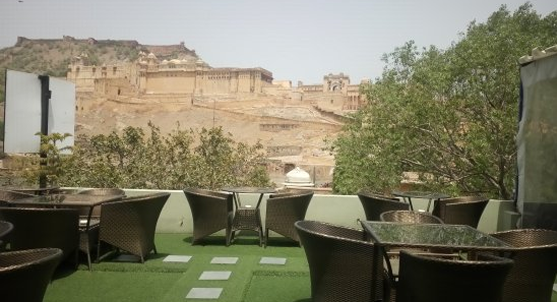
This restaurant, which serves delectable dinners to guests from all over the world, is located around one mile from Jaigarh Fort. The breathtaking vista over the Jaigarh and Amer Forts is something that photographers visiting Jaipur won’t want to miss. A light but filling supper can help you get ready for your trip before you go on the road.
Kokum Bistro
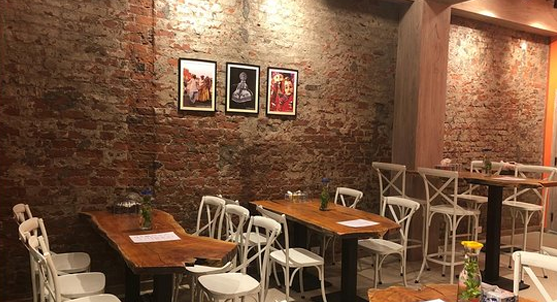
The Haathi bus station is located relatively close to the Jaigarh Fort, which is around a km away. The bistro is a great spot to unwind with friends, have a drink, and try some delectable cuisine. Being a family-run business, the café gives each patron their undivided attention and maintains a kind, inviting atmosphere.
1135 AD

About 1135 A.D., the Jaipur royal family started providing guests with delectable feasts at the Amer Palace. The restaurant is located inside the palace. Every dish is renowned for the attention to detail that went into making and serving them. You are around 700 metres away from Jaigarh Fort. It’s stated that the flavour are outstanding, however, thus the rather expensive price is offset. Make a reservation at this exquisite restaurant in Jaigarh Fort to enjoy a variety of experiences, such as throwing a private party or just feeling like royalty. The restaurant is divided into many unique areas such as the Diwan-e-khaas, the Shahi Angan, and the Swarna Mahal.
If you’d want to sample some street cuisine, there are plenty of vendors in front of the fort. These shops provide traditional foods including samosas, jalebi, kachori and aloo, and more. Explore the magnificent Jaigarh Fort to get a taste of some of Jaipur’s rich cultural heritage. We at Jaipur Tourism, a branch of Holidays DNA, are happy to provide you with affordable Jaipur Tour packages so that you may have an even better time in Jaipur. Choose the trip that best fits your interests to learn about the architectural and historical treasures of the “Pink City.”
How To Reach
The nearest airport to Jaigarh Fort is located in Jaipur. By air, Jaipur is with connection to all of India’s major cities. From Jaipur International Airport, visitors may take buses, taxis, or even rickshaws to the fort of Jaigarh. When looking for transportation from the fort to the airport, buses provide the highest degree of comfort and value. However, private taxis and rickshaws are also available for hire, although at a higher price.
Best Time To Visit
The best time to visit the fort is from November through February. Winter has come in Amer, and although the nights may be frosty, the mornings are still warm and pleasant, making it a great time to explore the fort.The public may visit the Fort every day from 9:00 AM to 4:30 PM. You should visit the fort at least three hours in advance if you want to have plenty of time to explore the area and snap pictures without worrying about being interrupted.
1. Admission for Indian citizens is thirty-five rupees.
2. To enter India, foreign people must pay a charge of Rs. 85 per person.
3. Jaipur, sometimes referred to as the Pink City, has lovely skies and a comfortable temperature.






